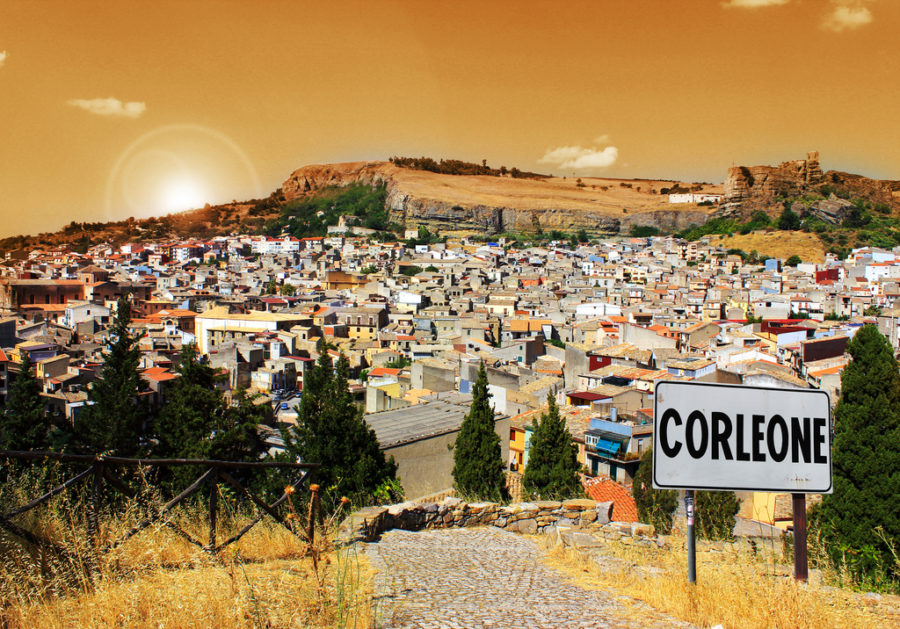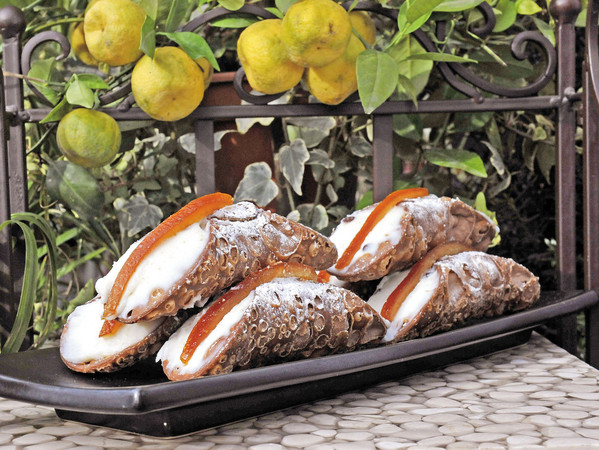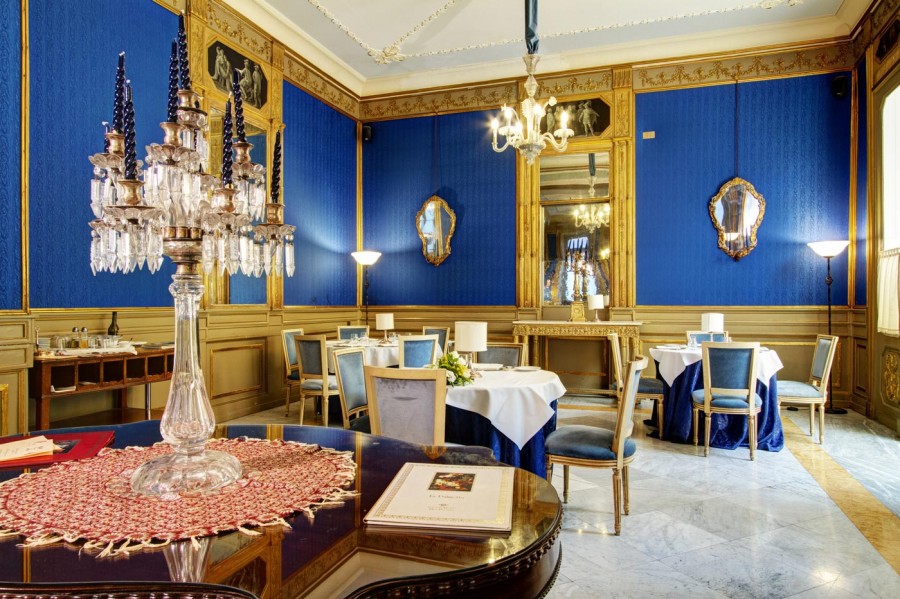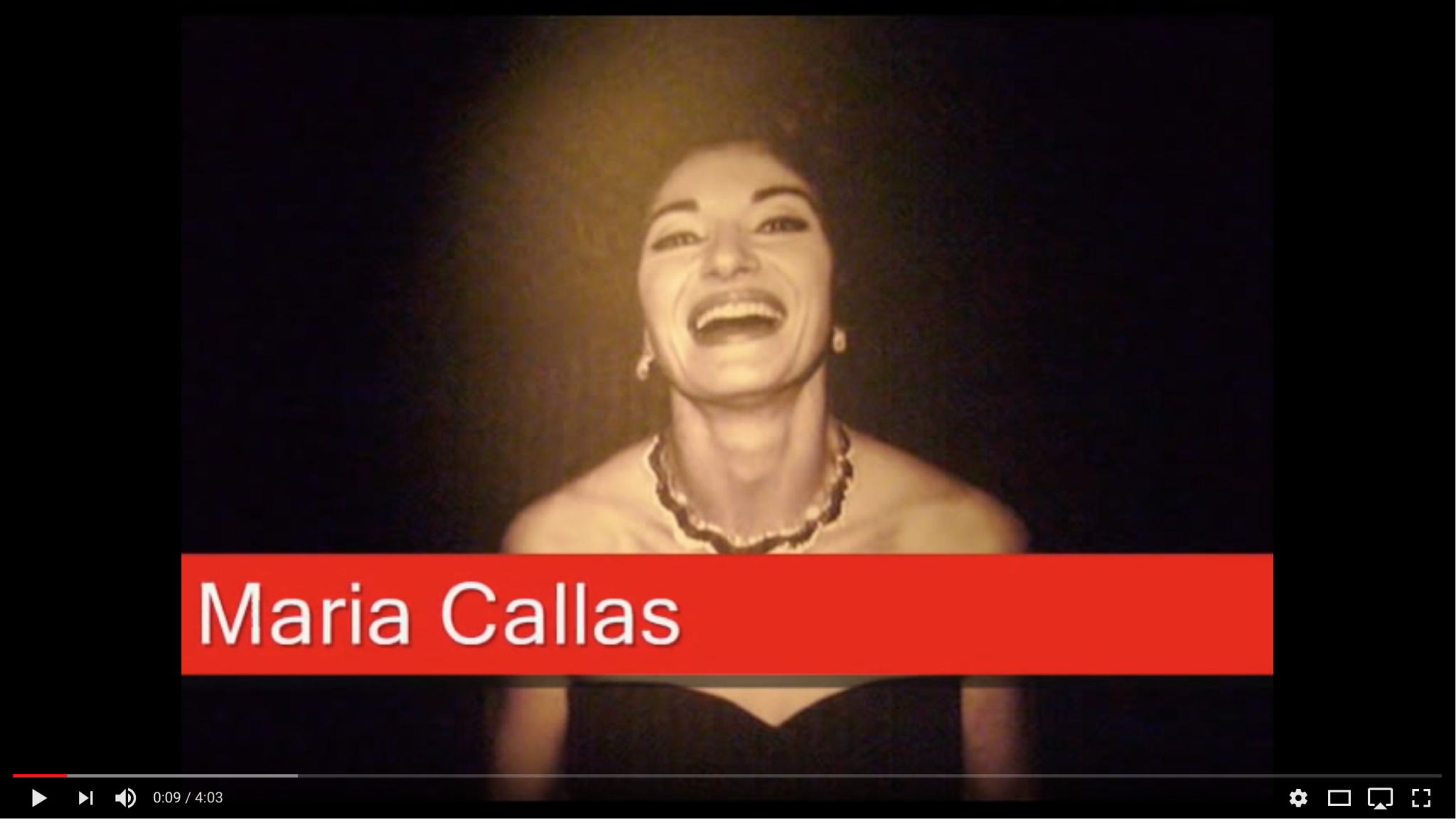THE SICILIAN PASTRY TRAIL

THE SICILIAN PASTRY TRAIL PART 1
Throw away your travel guide. All you need as a guide to Sicily is a sweet tooth!
If you seek out Sicily’s best pastries, you will automaticaly encounter all the most beautiful people, places, rich traditions and wonderful food and wine this island of the sun has to offer and in between mouthfuls of the crispiest and creamiest pastries in the world, you will bear witness to an exciting cultural renaissance.
Start in Palermo and head straight to the Pasticceria Scimone, the old pastry shop that sells Apostles’ Fingers, for a memorable taste of Sicilian Catholicism. Soft cream and ricotta mousse languishes within a light casing of golden pastry, powdered with heavenly cinnamon and icing sugar. You can choose between chocolate, pistaccio, wild strawberry or cinnamon fillings, a great introduction to Sicilian signature flavours. This recipe for Apostles’ Fingers is copyrighted, so you wont find them anywhere else. Follow the advice of the baker, who says; do not just nibble these fingers, put the whole digit into your mouth all at once. Only then will you be taken to paradise!
The pasticceria is within strolling distance of the twelfth century cathedral and the catacombs of Porta D’Ossuna from the earliest origins of Catholicism. All the religious history is so much easier to swallow after a communion of sublime Apostle’s Finger.
 In Palermo you will find some of the most breathtaking baroque architecture, whilst on a quest for the most delicious Cannoli, the world famous pastry tubes oozing with fresh ricotta. Sicilian baroque has more flourish than anywhere else, more curves, more putti, more embellishment; so too the Cannoli. Perhaps the best ones are made at the now shuttered monastery of Sant’Andrea. But the most infamous Cannoli were lying on the back seat of the car in Francis Ford Coppola’s epic film, The Godfather.
In Palermo you will find some of the most breathtaking baroque architecture, whilst on a quest for the most delicious Cannoli, the world famous pastry tubes oozing with fresh ricotta. Sicilian baroque has more flourish than anywhere else, more curves, more putti, more embellishment; so too the Cannoli. Perhaps the best ones are made at the now shuttered monastery of Sant’Andrea. But the most infamous Cannoli were lying on the back seat of the car in Francis Ford Coppola’s epic film, The Godfather.
In true Mafia style, Frank Sinatra is known to have especially enjoyed his Sicilian pastries and confectionary. His roots lie in mafia hotspot Lercara Friddi, though he always denied it because it was also the birthplace of Lucky Luciano. Every year, Sinatra’s life is celebrated there at the annual My Way Festival. Admission is free. The Orien’s Bar is famous for it’s cakes, which are all homemade with the freshest local ingredients. Sinatra’s favourite was Lemon Ricotta Cake. This is best accompanied by the Orien’s home made aperitifs, which will put you in a very good nostalgic mood.
‘Candy, I call my sugar Candy, because I’m sweet on Candy …..’ seems like only yesterday.
Just along the road in a beautiful and unique mediterranean canyon, Corleone is not to be missed. This is the little town immortalised in the Godfather film. It was one of the murder capitals of the world. Now it hosts a mafia museum, which must be a good sign that they are trying to consign Cosa Nostra to history. At the celebrated 5 Stelle Pasticceria, they sell a deconstructed Cannole, another signal that hundreds of year of old traditions in Sicily are being turned inside out, whilst the flavour and character are preserved.
 When you return to Palermo, make sure you’ve booked into the luxurious Grand Hotel Delle Palme. Walk along the blood red carpets that cut through the marble pillars and statues in the footsteps of the most notorious mafiosi in history. It was here that American mobsters Carmine Galante, Joe Bonanno, also known as ‘Joey Bananas’, and Lucky Luciano met with Sicilian mafia boss Salvatore “Little Bird” Greco, also known as ‘The Pope’, and Gaetano Badalamenti in October 1957. They went to the equally luxurious Spanò seafood restaurant nearby, to have a meeting that came to be known as the Heroin Summit. It was here they plotted the ‘French Connection’ over lunch. Luciano, no doubt ate his favourite Spaghetti Marinara. Also meeeting them was the man who would become the Mafia’s most nototious informer, Tommaso Buscetta. One of the outcomes of this meeting was that the Sicilian Mafia composed its first Commission, replicating the American Mafia. Bonamno was treated as the guest of honour by his old friend, Lucky Luciano. The police, who had been keeping Luciano under observation, followed their every move. But it took eight years before their report saw the light of day, or any of the individuals present were indicted in Palermo. After many years, and countless tragic deaths, the tide may be beginning to turn at last.
When you return to Palermo, make sure you’ve booked into the luxurious Grand Hotel Delle Palme. Walk along the blood red carpets that cut through the marble pillars and statues in the footsteps of the most notorious mafiosi in history. It was here that American mobsters Carmine Galante, Joe Bonanno, also known as ‘Joey Bananas’, and Lucky Luciano met with Sicilian mafia boss Salvatore “Little Bird” Greco, also known as ‘The Pope’, and Gaetano Badalamenti in October 1957. They went to the equally luxurious Spanò seafood restaurant nearby, to have a meeting that came to be known as the Heroin Summit. It was here they plotted the ‘French Connection’ over lunch. Luciano, no doubt ate his favourite Spaghetti Marinara. Also meeeting them was the man who would become the Mafia’s most nototious informer, Tommaso Buscetta. One of the outcomes of this meeting was that the Sicilian Mafia composed its first Commission, replicating the American Mafia. Bonamno was treated as the guest of honour by his old friend, Lucky Luciano. The police, who had been keeping Luciano under observation, followed their every move. But it took eight years before their report saw the light of day, or any of the individuals present were indicted in Palermo. After many years, and countless tragic deaths, the tide may be beginning to turn at last.
2018 is a good year to stay in Palermo because it has been nominated City of Culture 2018. It gives Palermo the opportunity to celebrate the progress that has been made, spearheaded by a courageous new generation. The beautiful old piazzas have been reclaimed from the illegal carparks, attracting a new crowd. Shops, restaurants and cafes are refusing to pay the “pizzo” mafia protection money, that has been holding businesses to ransom for generations. Palermo’s regenerated yacht harbour and marina, once a no-go zone filled with rubbish and drug pushers, are testimony to this Renaissance. It is in that spirit that the famous words in The Godfather should always be remembered:
“Leave the gun, take the Cannoli”.
SICILIAN ODYSSEY – THE SICILIAN PATRY TRAIL PART 2
According to popular wisdom, cannoli were invented in an Arabic harem in Caltanissetta, in the wild heartlands of the island. In another legend it wasn’t a harem but a convent of nuns, who made these infamous pastries for the sultans. In a hybrid legend the harem concubines became nuns! This may explain why there seems to be so much sexual symbolism in Sicilian pastry making. Cannoli are recognised phallic symbols. Since Roman times at least, the phallus has played the crucial role of warding off the Evil Eye. This is as good an excuse as any to journey to the source, Caltanissettta, to seek out the biggest protection from the Evil Eye you can find. The Pasticceria Delizie d’Autore in Viale Trieste can deliver!
Another typical confectionary from Caltanissetta is the Arabic Cubaita. It is a kind of torrone made with caramelised sugar, sesame, almonds, pistachios and honey. You can store it easily in a backpack and cycle along the roads between the wheat fields and peach orchards to explore the surrounding villages. Just don’t have it in your mouth when you go over the bumps. When you arrive in the village of Delia, you can stock up on Cuddrureddra. These biscuits in the shape of little crowns are made with  cinnamon, wine and orange peel. They have been given protected status as a Slow Food Presidium. Originally these biscuits were baked to honour the noblewomen living in Delia during the 13th-century War of the Sicilian Vespers. This war has been immortalised by Giuseppe Verdi’s opera of 1855. Opera and Cuddrureddra are the perfect accompaniment for your Sicilian odyssey.
cinnamon, wine and orange peel. They have been given protected status as a Slow Food Presidium. Originally these biscuits were baked to honour the noblewomen living in Delia during the 13th-century War of the Sicilian Vespers. This war has been immortalised by Giuseppe Verdi’s opera of 1855. Opera and Cuddrureddra are the perfect accompaniment for your Sicilian odyssey.
The village of Santa Rita is just a little group of houses nestling in the Agrigento countryside where an ancient wood-burning stone oven was dicovered and restored and put back to work. Stone milling was reestablished using old Sicilian native grains and bread is baked according to an ancient Sicilian recipe. You can eat Sicilian history here in the form of delicious pizzas, biscuits, tarts, and almond and pistachio sweets. Visit: http://fornosantarita.com.
Favara is called the city of Easter lamb and makes Easter lamb cakes with marzipan, pistaccios and sugar. It just so happens that this rundown and impoverished town has recently been transformed into a ‘capital of cool’ with the launch of the Farm Cultural Park. https://www.farmculturalpark.com. The entire historical centre has become a gallery to display contemporary artists and photographers from across the globe and is now attracting international audiences.
ALIVE AND KICKING ; THE SICILIAN PASTRY TRAIL PART 3
The third part of our Sicilian odessey brings us to Taormina, The Pearl of the Ionian, with spectacular views of Mount Etna. It has inspired visitors for over 2,500 years. Artists, aristocrats and famous actors have all flocked here, to the Cradle of European Civilisation.
It is interesting that Greta Garbo, who famously said ‘I Vant to be alone’, found the solitude she craved in this illustrious ancient city she loved. Garbo came as a regular guest of Gaylord Hauser, the famous Hollywood dietician to the stars, who had a house here. He would prescribe celery and mollasses to his clients, before retreating to his Island of pastries.
 Solitude is a little more difficult in Taormina these days, unless you book into the luxury boutique Hotel Villa Carlotta , a secret refuge only minutes by complimentary shuttle from the beach at Isola Bella. But you can relax by the pool in peace, protected from the crowds, before heading for tourist traps.
Solitude is a little more difficult in Taormina these days, unless you book into the luxury boutique Hotel Villa Carlotta , a secret refuge only minutes by complimentary shuttle from the beach at Isola Bella. But you can relax by the pool in peace, protected from the crowds, before heading for tourist traps.
Goethe, Maupassant, Oscar Wilde, Brahms, amongst many creative souls, have drawn inspiration from Taormina. D H Lawrence’s ‘Lady Chatterley’s Lover’ is said to have been inspired by his wife’s infatuation with a local mule driver. More recently, Dire Straits’ Mark Knopfler was inspired to write ‘Lights of Taormina’, after performing at the ancent Greek Theatre in 2013. He was staying at Simple Minds’, Jim Kerr’s Hotel Villa Angela when he wrote the song, set on a hillside overlooking the town. Simple Minds have played at Taormina on more than one occasion. ‘Alive and Kicking’ could be an anthem to Jim Kerr’s beloved home from home with heart stopping views of Mount Etna….
“Oh you lift me up to the crucial top, so I can see
Oh you lead me on, till the feelings come
And the lights that shine on….”
(Simple Minds 1985)
Legend has it that King Arthur’s Avalon is hidden in a cave on Mount Etna.
Certainly the atmosphere of ancient mystery pervades the air in the towns circling the volcano. Here the farmers have survived the eruptions and make the most of the lava enriched soil by growing peaches, kiwi, mangoes, oranges and enormous lemons, little Etna apples, plums, pears and then, towards to the edge of the lava level, sweet chestnuts, almonds, hazelnuts and the most delicious pistachios in the world.
The mountain town of Bronte, is famous for its pistachio production. These little emerald jewels are harvested every two years instead of every year ,for extra flavour. The pasticceria owner sprinkles her pistachio nuts on everything from Cannoli to pasta. You can eat your fill because pistachios are life enhancing with proven health benefits. They reduce the risk of heart attack, stroke and diabetes, boost immunity, are beneficial for digestive health and aid cellular repair. They are also aphrodisiac. Therefore Bronte must be on the travel itinerary.
Linguaglossa always conjures images of Grand Tour artists braving the sulphur to paint the erupting volcano. The Nonsense poet Edward Lear was one of England’s finest landscape artists, sadly now only remembered for his nonsense rhymes. He climbed the volcano with the aid of a mule. “One is amply repaid by the extraordinary scene above, where you look on the whole island of Sicily just like a great pink map in the sky, with the sea round it so blue, and the dark purple triangular shade of the mountains over that part furthest from the sun which rose just before we got to the mouth of the crater.” He claimed boiled broad beans kept him alive for the entire journey. Of course the life potency of beans is recognized in cultures across the globe.
Life giving wine, Etna Bianco Superiore Doc, is produced exclusively around Milo, on the eastern slopes. It is a good place to cool down, as the nearby woods keep the place cooler than everywhere else. The only exception was in 1950 when the villagers narrowly escaped molten lava and had to be evacuated for a year.
In the village of Zafferano Etnea, on the slopes of the volcano, an ancient symbiosis binds beekeepers to their precious honey bees. There are over eight hundred beekeepers living there and practicing this ancient tradition. An Apicultural Museum recreates the lifestyle of the beekeepers of the early 1900’s, an evocative journey into Sicilian social history. You can taste and buy a myriad of honey varieties: Orange Blossom, Eucalyptus, One Thousand Flower, Thyme, Indian Fig, Chestnut, Acacia. They also produce honey cream in hazelnut, pistachio, banana, strawberry and mixed berry flavours. The honey is used in nougats, “mostaccioli” and “zeppole”…a fried kind of doughnut dripping with honey, which was a Frank Sinatra favourite. The honey has healing and restorative properties, which means you can consume Zeppole with no guilt whatsoever, although your waistline may soon need some attention.
It is worth visiting Sicily when it sleeps in the winter sun, to work off the calories on skis. There are two small ski resorts on Etna. Rifugio Sapienza on the southern slope is livelier, Piano Provenzana on the northern slope is prettier. ‘The Skier’ was invented to meet the energy needs of skiers returning from the Etna ski slopes. It’s made of chocolate, fondant, almonds, hazelnuts, pistachio, ricotta chips and fragrant almond-shaped biscuits called “tea leaves”. The recipe is top secret, which is good because it would be death by chocolate if you took that recipe home.
The chocolate of the Unesco World Heritage town of Modica, is one of the world’s best kept secrets, alongside its beautiful Baroque architecture. The chocolate is an ancient and original recipe of the Aztecs. introduced by the Spaniards. The chocolate industry survived the 1693 earthquake against all odds and now it is a protected ‘species’. The tradition of chocolate making here is taken very seriously indeed. In December, the annual ChocoModica festival is celebrated with gusto. There’s even a chocolate museum and you can get chocolate recipes dating back to the 1740s.
The city of Ragusa, ‘the island within an island’, has died and been reborn. The old part of the city is built out of the ruins of ancient cities and rebuilt yet again after the earthquake of 1693. It was also declared a UNESCO World Heritage Site to protect its exquisite Baroque buildings . The Ibla, the old historical centre, has over fifty churches and palaces. dominated by the dome of the Cathedral of San Giorgio. The rich architecture with its scrolls, columns and statues, is an exquisite expression of Sicilian Baroque. Perhaps it is that sense of preservation that also produced their unique Salted Cannoli.
The Realais Antica Badia Hotel is set within 18th century halls, meticlously restored to their former glory. Book the Hammam for a wonderfully restoratative breathing space.
The Val di Noto is also protected by UNESCO for its architectural masterpieces.
Noto is the beautiful capital of almonds and land of green lemon cake. Caffè Sicilia just won an important prize for its cakes. Founded in 1892, it is well known locally for its fruit preserves in flavours like bergamot and mulberry. It also produces orange and wild fennel ice cream with chilli. Caffe Costanzo, by contrast is famed for its refreshing jasmine granita, made with mineral water in which the jasmine flowers, picked at dusk, have steeped overnight.
Facciuni di Santa Chiara are created by the nuns of the monastery of that name, in Noto. These voluminous domes (the larger ones can reach 30 cms in diameter) made with preserves of citrus fruits, in particular cedar and orange or dried figs, and covered in an aromatic dark chocolate glaze, are often sprinkled with coloured confetti which represent the angels of heaven.
 Scicli is possibly he most beautiful of Sicily’s UNESCO listed Baroque towns, well known as the fictional town “Vigata” in the Inspector Montalbano series. Tourists visiting Scicli would be greeted by Italo, a stray dog who has become as famous as Montalbano. The story is that he wandered into town after the death of his owner. He would escort tourists around the Baroque buildings, he would accompany children home from school and was a regular churchgoer, participating in mass, weddings and funerals. He used to meet one young man at a bar every morning, and when tragically the man died prematurely, Italo lay in vigil by the coffin until the funeral. He became the towns beloved mascot. The mayor provided Italo with a kennel in the square and he was made an honoury citizen of Scicli, much loved by everyone until he died. Italo is buried in the grounds of the historic Villa Penna.
Scicli is possibly he most beautiful of Sicily’s UNESCO listed Baroque towns, well known as the fictional town “Vigata” in the Inspector Montalbano series. Tourists visiting Scicli would be greeted by Italo, a stray dog who has become as famous as Montalbano. The story is that he wandered into town after the death of his owner. He would escort tourists around the Baroque buildings, he would accompany children home from school and was a regular churchgoer, participating in mass, weddings and funerals. He used to meet one young man at a bar every morning, and when tragically the man died prematurely, Italo lay in vigil by the coffin until the funeral. He became the towns beloved mascot. The mayor provided Italo with a kennel in the square and he was made an honoury citizen of Scicli, much loved by everyone until he died. Italo is buried in the grounds of the historic Villa Penna.
Now we head back north to Siracuse, the town described as a crumbling antique paintin. To the ancient Greeks this was the greatest city in the world, with a vast temple, now the cathedral, an amphitheatre and a theatre, where one of the first comedies ever was staged. Plato and Archimedes were in the audience.
The dead and buried are omnipresent in Sicily and the citizens are left with little choice but to make friends with the grim reaper, so it is symbolised in pastry, of course. Syracusan Toto biscuits are prepared for the festival of the Dead. They are made in black, chocolate flavoured, and white, lemon flavoured. On the night of November 1st and 2nd, bread and water are left as an offering to the dead, who are said to rise from their graves to bring gifts to their living relatives, before returning to their resting place. They leave biscuits and sweets hidden around the house, especially in shoes… a treasure hunt for the children.
Similarly, Pipareddi Messinesi are particularly crunchy representations of the Bones of the Dead, made with a dark centre coated in a lighter crispy shell. On All Saints Day, the dead are said leave their graves and parade in a procession. First out are those who died because they were executed, then those who died in disgrace, then those who died suddenly and finally all other ordinary deaths by natural causes. Sicily has seen them all .
Life and death are never so united as in Sicily. The animated and passionate Sicilians, these children of fate, have throughout history turned adversity, subordination, death and decay into vibrant expressions of life force, in art, architecture and the best pastries in the world, edible poetry as eternal as Virgil ’s Aeneid.
Artists, poets and cooks who visit Sicily are always rewarded with a volcanic creative force.
‘What are you going to do with the flames go up?’…..


